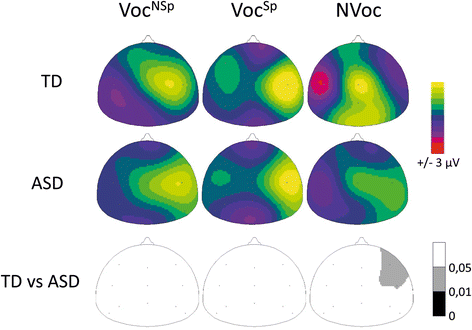Atypical sound discrimination in children with ASD as indicated by cortical ERPs
- PMID: 28396700
- PMCID: PMC5381025
- DOI: 10.1186/s11689-017-9194-9
Atypical sound discrimination in children with ASD as indicated by cortical ERPs
Abstract
Background: Individuals with autism spectrum disorder (ASD) show a relative indifference to the human voice. Accordingly, and contrarily to their typically developed peers, adults with autism do not show a preferential response to voices in the superior temporal sulcus; this lack of voice-specific response was previously linked to atypical processing of voices. In electroencephalography, a slow event-related potential (ERP) called the fronto-temporal positivity to voice (FTPV) is larger for vocal than for non-vocal sounds, resulting in a voice-sensitive response over right fronto-temporal sites. Here, we investigated the neurophysiological correlates of voice perception in children with and without ASD.
Methods: Sixteen children with autism and 16 age-matched typically developing children heard vocal (speech and non-speech) and non-vocal sounds while their electroencephalographic activity was recorded; overall IQ was smaller in the group of children with ASD. ERP amplitudes were compared using non-parametric statistical tests at each electrode and in successive 20-ms time windows. Within each group, differences between conditions were assessed using a non-parametric Quade test between 0 and 400 ms post-stimulus. Inter-group comparisons of ERP amplitudes were performed using non-paired Kruskal-Wallis tests between 140 and 180 ms post-stimulus.
Results: Typically developing children showed the classical voice-sensitive response over right fronto-temporal electrodes, for both speech and non-speech vocal sounds. Children with ASD did not show a preferential response to vocal sounds. Inter-group analysis showed no difference in the processing of vocal sounds, both speech and non-speech, but significant differences in the processing of non-vocal sounds over right fronto-temporal sites.
Conclusions: Our results demonstrate a lack of voice-preferential response in children with autism spectrum disorders. In contrast to observations in adults with ASD, the lack of voice-preferential response was attributed to an atypical response to non-vocal sounds, which was overall more similar to the event-related potentials evoked by vocal sounds in both groups. This result suggests atypical maturation processes in ASD impeding the specialization of temporal regions in voice processing.
Keywords: Auditory; Autism; Development; FTPV; Speech; Voice.
Figures




References
-
- Kanner L. Autistic disturbances of affective contact: publisher not identified. Nervous Child. 1943;2(3):217–50.
-
- Association D-AP . Diagnostic and Statistical Manual of Mental Disorders. Arlington: American Psychiatric Publishing; 2013.
LinkOut - more resources
Full Text Sources
Other Literature Sources

